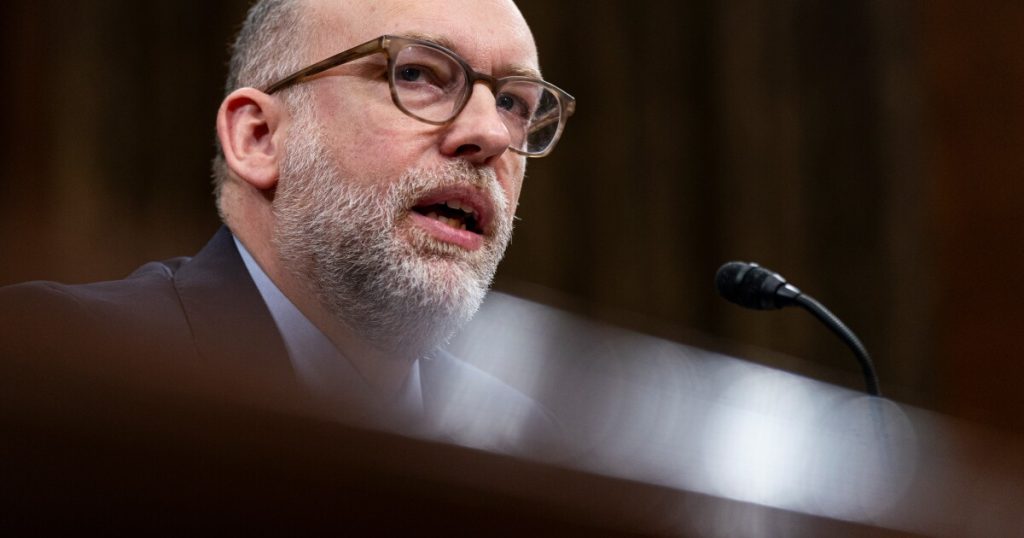- Key Insight: Acting CFPB Director Russell Vought claims the agency will run out of funding by year-end and cannot pay employees, so it is transferring its remaining litigation duties to the Justice Department.
- What’s at Stake: Vought was sued by the National Treasury Employees Union in March and a district court issued a preliminary injunction that prohibits the bureau from firing employees through a reduction-in-force.
- Forward Look: The bureau is making other changes that indicate a shutdown is coming including plans for a new method for the mortgage industry to calculate the Average Prime Offer Rate themselves.
The Consumer Financial Protection Bureau plans to transfer all of its litigation activities to the Department of Justice and expects to furlough all in-house enforcement attorneys, despite a preliminary injunction that prohibits the agency from mass firings.
At an all-hands meeting held late Thursday, Michael Salemi, the CFPB’s principal deputy enforcement director and acting director of enforcement, told enforcement staff that more than 100 people would be furloughed because the CFPB is going to run out of money, according to several people on the call. All open cases in the enforcement division, as well as work by the legal division, will be transferred to the Justice Department, Salemi told staff.
The announcement comes after Acting CFPB Director Russell Vought said last week that the CFPB will only have enough money to operate through year-end. The CFPB said in
The move drew condemnation from Sen. Elizabeth Warren, the ranking member of the Senate Banking Committee, who said the administration is “transferring away all of the CFPB’s active litigation.”
“Nobody is fooled about the Trump-Vought end game, and the courts must uphold the law,” Warren said in a press release. “Donald Trump and Russ Vought are racing to shut down the CFPB while their lawyers tell the courts the opposite.”
Vought is looking to dismantle the CFPB under a novel legal theory that because the Federal Reserve System has been unprofitable since 2022, the director of the bureau cannot request funding due to specific language in the Dodd-Frank Act. Notably, the CFPB has been funded for the past two years even though the Fed has been unprofitable.
At the same time, the bureau is operating under a preliminary injunction prohibiting it from mass layoffs in a lawsuit brought by the National Treasury Employees Union against Vought.
In March, District Court Judge Amy Berman Jackson issued a preliminary injunction requiring the preservation of the CFPB’s operations and employees including a stop-work order. But a three-judge panel of the the U.S. District Court for the District of Columbia ruled that Vought can fire up to 90% of employees. That ruling is on appeal.
Many expect more litigation from the move to transfer all litigation to the DOJ. In the meantime, the CFPB is making several changes to prepare for a shutdown.
At the all-hands meeting on Thursday, Salemi told employees that he had limited information from senior CFPB officials. He said the enforcement team likely will be furloughed by year-end. A few top officials may have the opportunity to work for DOJ, people who heard the call said.
CFPB Union President Cat Farman called the move to end funding the “latest illegal power grab,” by Vought. She also said that enforcement attorneys are concerned that the CFPB will dismiss the remaining 13 cases currently in litigation that will be transferred.
But Farman went much further by calling on Congress to remove Vought from the agency.
“If Vought is going to keep refusing to fund [the] CFPB in order to illegally dismantle the agency, while he wastes over $5 million of CFPB’s dwindling budget on personal bodyguards, then it’s time for Congress to impeach and remove Russell Vought from power.”
Vought, who is also the director of the Office of Management and Budget, and is a key architect of Project 2025, the Trump administration’s blueprint for reducing the federal government, has had the OMB bill the CFPB nearly $5 million for his own security detail.
The CFPB’s funding mechanism has already endured one Supreme Court challenge. And in July, the Republican-controlled Congress cut the CFPB’s funding in half. The agency’s funding is capped at $446 million in fiscal 2025, down from $823 million last fiscal year. Since Vought took control in February, he has not requested any funding, but instead said the CFPB had enough funds so he didn’t need to tap the Federal Reserve.
The CFPB had to take a rather circuitous route to gut the agency’s funding.
Last week the Justice Department
The CFPB said that DOJ’s Office of Legal Counsel “made this conclusion on the basis that the Federal Reserve System currently lacks any ‘combined earnings’ from which the Bureau may draw funding, as required by Dodd-Frank. OLC opinions are binding upon Executive Branch agencies including the Bureau.”
Preparing for a shutdown is underway.
CFPB officials are creating a contingency plan for mortgage lenders to work out the Average Prime Offer Rate, or APOR, if the agency shuts down. The CFPB calculates and publishes weekly APOR rates, which provide a benchmark and stability for mortgage lending, and are used to determine Ability-to-Repay rules.
CFPB officials are planning to publicly outline a new method for calculating APOR that would allow the industry to calculate it for themselves by providing an alternative use of readily-available data, people familiar with the matter said. It is unclear yet whether the approach will be accepted by lenders. One expert said the secondary market for mortgage credit could shown signs of strain because of “very real private liability concerns.”
The change in APOR, the refusal to request funding as well as recent proposals to change Biden-era rules suggest that Vought preparing for a future in which the CFPB is not fully-functioning, if at all.
Last week, the CFPB issued two proposed rulemakings — making major changes to the 1071

